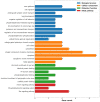Genome-Wide Association Studies for Body Conformation Traits in Korean Holstein Population
- PMID: 37760364
- PMCID: PMC10526087
- DOI: 10.3390/ani13182964
Genome-Wide Association Studies for Body Conformation Traits in Korean Holstein Population
Abstract
The objective of this study was to identify quantitative trait loci (QTL) and nearby candidate genes that influence body conformation traits. Phenotypic data for 24 body conformation traits were collected from a population of 2329 Korean Holstein cattle, and all animals were genotyped using the 50 K Illumina bovine SNP chip. A total of 24 genome-wide significant SNPs associated with 24 body conformation traits were identified by genome-wide association analysis. The selection of the most promising candidate genes was based on gene ontology (GO) terms and the previously identified functions that influence various body conformation traits as determined in our study. These genes include KCNA1, RYBP, PTH1R, TMIE, and GNAI3 for body traits; ANGPT1 for rump traits; MALRD1, INHBA, and HOXA13 for feet and leg traits; and CDK1, RHOBTB1, and SLC17A1 for udder traits, respectively. These findings contribute to our understanding of the genetic basis of body conformation traits in this population and pave the way for future breeding strategies aimed at enhancing desirable traits in dairy cattle.
Keywords: Korean Holstein; body conformation traits; candidate gene; genome-wide association study.
Conflict of interest statement
The authors declare no conflict of interest.
Figures
Similar articles
-
Genome-wide association analysis of body conformation traits in Chinese Holstein Cattle.BMC Genomics. 2024 Dec 3;25(1):1174. doi: 10.1186/s12864-024-11090-8. BMC Genomics. 2024. PMID: 39627684 Free PMC article.
-
Evaluation of accuracies of genomic predictions for body conformation traits in Korean Holstein.Anim Biosci. 2024 Apr;37(4):555-566. doi: 10.5713/ab.23.0237. Epub 2024 Jan 20. Anim Biosci. 2024. PMID: 38271974 Free PMC article.
-
Genome wide association studies for body conformation traits in the Chinese Holstein cattle population.BMC Genomics. 2013 Dec 17;14:897. doi: 10.1186/1471-2164-14-897. BMC Genomics. 2013. PMID: 24341352 Free PMC article.
-
Underlying genetic architecture of resistance to mastitis in dairy cattle: A systematic review and gene prioritization analysis of genome-wide association studies.J Dairy Sci. 2023 Jan;106(1):323-351. doi: 10.3168/jds.2022-21923. Epub 2022 Nov 1. J Dairy Sci. 2023. PMID: 36333139
-
Genome-wide selection signatures detection in Shanghai Holstein cattle population identified genes related to adaption, health and reproduction traits.BMC Genomics. 2021 Oct 15;22(1):747. doi: 10.1186/s12864-021-08042-x. BMC Genomics. 2021. PMID: 34654366 Free PMC article. Review.
Cited by
-
Genome-wide association and functional genomic analyses for body conformation traits in North American Holstein cattle.Front Genet. 2024 Oct 24;15:1478788. doi: 10.3389/fgene.2024.1478788. eCollection 2024. Front Genet. 2024. PMID: 39512801 Free PMC article.
-
Genomic prediction and genome-wide association studies of morphological traits and distraction index in Korean Sapsaree dogs.PLoS One. 2024 Nov 21;19(11):e0312583. doi: 10.1371/journal.pone.0312583. eCollection 2024. PLoS One. 2024. PMID: 39570887 Free PMC article.
-
Advancements in copy number variation screening in herbivorous livestock genomes and their association with phenotypic traits.Front Vet Sci. 2024 Jan 11;10:1334434. doi: 10.3389/fvets.2023.1334434. eCollection 2023. Front Vet Sci. 2024. PMID: 38274664 Free PMC article. Review.
-
Genome-Wide Association Study as an Efficacious Approach to Discover Candidate Genes Associated with Body Linear Type Traits in Dairy Cattle.Animals (Basel). 2024 Jul 26;14(15):2181. doi: 10.3390/ani14152181. Animals (Basel). 2024. PMID: 39123707 Free PMC article. Review.
-
Genome-wide association studies for milk production traits and persistency of first calving Holstein cattle in Türkiye.Front Vet Sci. 2024 Oct 24;11:1461075. doi: 10.3389/fvets.2024.1461075. eCollection 2024. Front Vet Sci. 2024. PMID: 39512914 Free PMC article.
References
-
- Meuwissen T., Hayes B., Goddard M. Genomic selection: A paradigm shift in animal breeding. Anim. Front. 2016;6:6–14. doi: 10.2527/af.2016-0002. - DOI
-
- Ma L. 301 Methods of genome-wide association studies and their applications in dairy cattle. J. Anim. Sci. 2020;98:31. doi: 10.1093/jas/skaa278.055. - DOI
LinkOut - more resources
Full Text Sources
Miscellaneous


